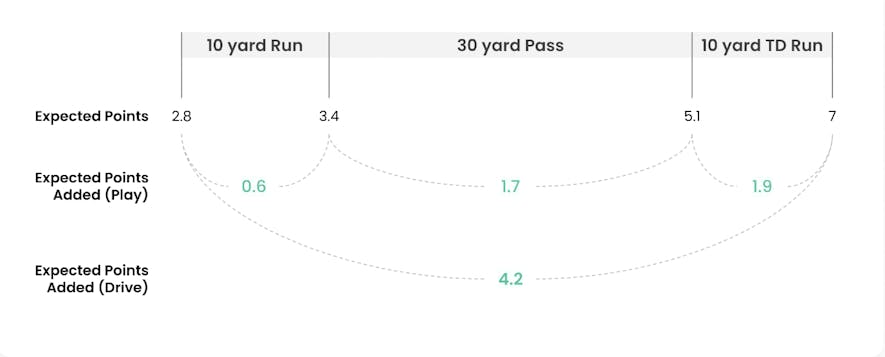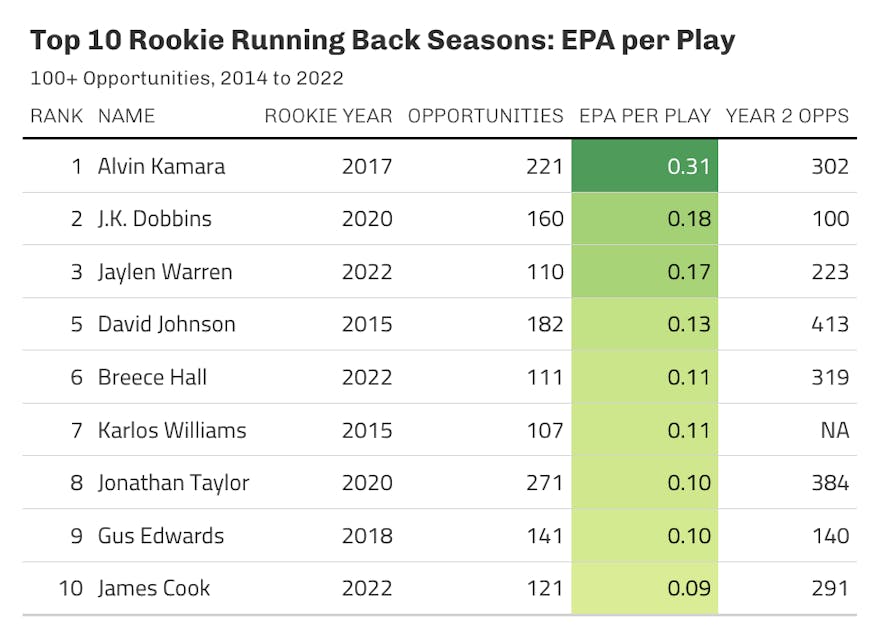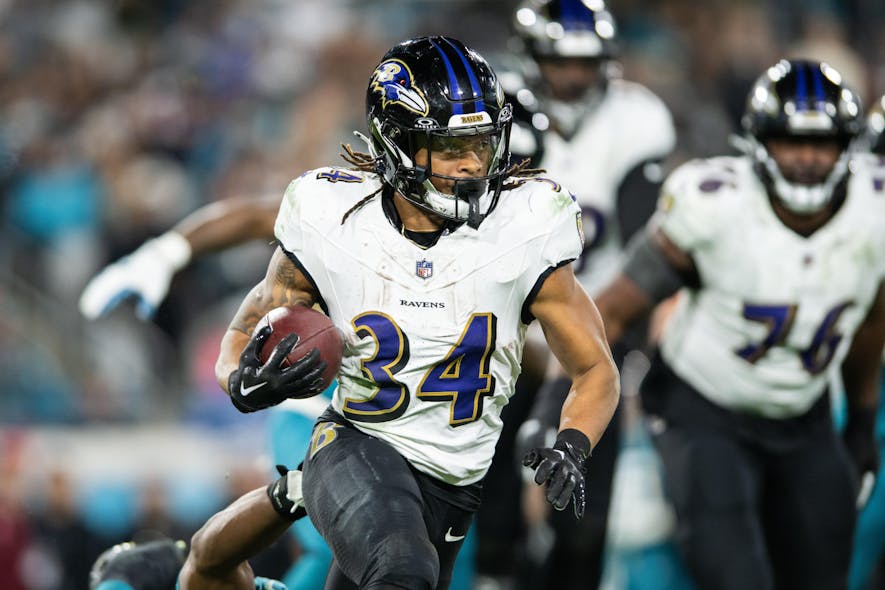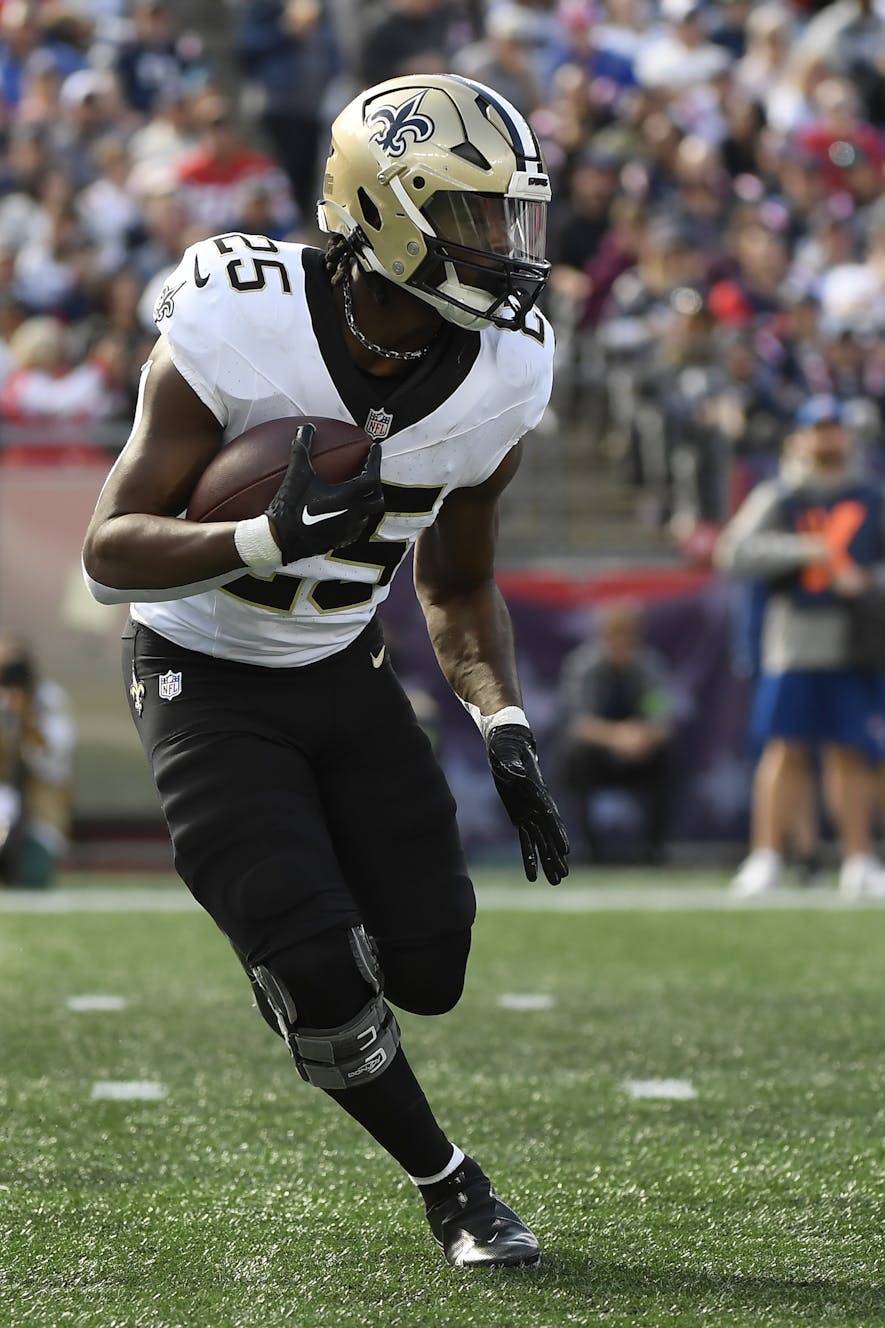
In my new weekly dynasty series, I crunch the numbers to find exploitable angles that can give us an edge in our dynasty leagues. Last week, we looked at whether running quarterbacks will likely have shorter careers. This week's article will look at the gold standard of advanced analytics -- Expected Points Added (EPA)-- to identify running backs we should be targeting in dynasty leagues.
The analysis shows that EPA is a good predictor of which running backs are likely to see more opportunities in the future. Given this information, we can identify some potentially undervalued running backs we should try to add to our dynasty rosters.
What is EPA?
Expected Points Added (EPA) is a football metric that quantifies the impact of individual plays on a team's scoring opportunities. The concept of EPA is based on the premise that not all yards or plays are equal—some have a greater influence on the likelihood of scoring than others. The origins of today's advanced EPA calculations can be traced back over 50 years to Bengals quarterback Virgil Carter. In 1970, Carter published a journal article with calculations for the average points per drive expected when a team has a first at different points on the field. ESPN's Ben Baby recently penned an insightful piece on Carter's influence. ESPN's Brian Burke further advanced Carter's work in 2008, laying the foundation for the modern EPA models that NFL teams now use to analyze games. As Baby highlighted in his article about Carter:
When the Bengals evaluated rushing offense this offseason, EPA was the first column as they ranked teams across the league by run concept. Veteran offensive line coach Frank Pollack, a no-nonsense ex-NFL lineman, was the one explaining the numbers to the rest of the staff.
If NFL teams (including old-school coaches like Frank Pollack) are using EPA extensively, it is safe to assume it will impact how coaches judge players' performance and decide who deserves to be featured in the future.
How EPA is Calculated
Expected Points (EP):
- EP is calculated based on the down, distance, and field position (yard line) at the start of a play. For example, if a team is starting a drive with 1st and 10 from their own 20-yard line, the expected points for the drive might be 2.8 based on a large library of historical data.
Calculate EP Before and After the Play, then subtract:
- Starting EP: Starting EP is the expected points scored on the drive at the start of the play. In our example of 1st-and-10 at our own 20-yard line, we will assume that the Starting EP is 2.0
- Post-Play EP: Post-Play EP is the expected points at the end of the play, based on the new down, distance, and field position after the play is completed. For the most basic example, imagine the play was an 80-yard touchdown run. Our Post-Play EP is 7.0.
- Expected Points Added (EPA): The long touchdown added 5.0 expected points (7.0 - 2.0). Of course, we can also calculate EPA for less extreme examples. Instead of an 80-yard touchdown run, let's say it was an 8-yard run. It is now 2nd-and-2 from our 28-yard line, and the Post-Play EP is 2.1. The EPA of the 8-yard run from that field position would be +0.1. Or let's say the play went for just a one-yard gain. It is now 2nd-and-9 from our own 21-yard line, and the Post-Play EP has dropped to 1.8. The EPA of the one-yard run was -0.2.
For more on EPA and its calculation, I highly recommend the article What are Expected Points Added (EPA) in the NFL. It includes a number of excellent visualizations, including this one showing how EPA might look for a successful touchdown drive and explaining the breakdown:

The touchdown is worth 7 points, but because the drive started in advantageous field position with an Expect Point value of 2.8, the drive added 4.2 points of EP. Of that 4.2 points worth of EP, 0.6 was added by the first run, 1.7 was added by the pass, and 1.9 was added by the second run -- each play contributed to the touchdown, and EPA tells us precisely what that contribution was.
Though simple in concept, this is a profoundly useful framework for analyzing the game of football.
Running Back EPA and Opportunities
Now that we have a basic understanding of EPA and how it is calculated on individual plays, let's dive into the numbers and examine the impact of EPA per play on future usage. We are going to look at opportunities. Opportunities are defined as carries plus targets. For example, last season Christian McCaffrey had 272 carries and 83 targets for a total of 355 opportunities.
For context, here are the 2023 leaders in EPA per play at the running back position (minimum of 50 opportunities):
The first thing that stands out is that three of the top four were rookies. Store that information away for now; we will get back to it later.
The big question is whether a strong EPA per play number in one season can help us predict whether a running back will get more opportunities the following year. The data is convincing—over the last decade, there has been a positive correlation (.153) between EPA and an increase in opportunities the following season.
Amongst all running backs since 2014 who had 50+ opportunities in a season, the next season, they averaged 37.5 fewer opportunities. This makes sense. Injuries occur. Running backs get older and are replaced. The shelf life of an NFL running back is relatively short, and when new running backs enter the league, the carries and targets they earn must come from somewhere.
Does EPA predict which RBs will see the biggest decrease in opportunities?
- Over the past decade, running backs with a negative EPA saw an average of 46.5 fewer opportunities the next season.
- In comparison, the running backs with a positive EPA had an average of 13.2 fewer opportunities the next season.
That is a substantial difference of 33.3 opportunities (carries + targets). The backs who produced negative EPA overall saw a massive reduction in workload the following year.
EPA and Rookie Running Backs
The numbers convincingly show that positive EPA leads to relatively more opportunities the next season than negative EPA for running backs. What do the numbers show for rookies?
Here are the leaders in EPA per play amongst all rookie running backs from 2014 to 2022:
A whopping 40% of the Top 10 rookie running backs over the last decade in EPA per play went on to have monster second seasons:
- Alvin Kamara saw his opportunities increase from 221 as a rookie to 302 in his second season. He turned those 302 opportunities (194 carries and 108 targets) into 348.2 fantasy points (PPR).
- David Johnson impressed on limited opportunities (182) as a rookie, earning a gargantuan increase to 413 opportunities his sophomore season. As a second-year pro, he finished as the overall RB1 with 377.0 fantasy points.
- Jonathan Taylor saw 113 more touches in his second season than he did as a rookie and finished his sophomore year as the overall RB1 with 377.1 fantasy points.
- Breece Hall flashed in 111 opportunities as a rookie before an ACL injury. He finished as the overall RB2 in his second season with 288.5 fantasy points.
With very few exceptions, the rookie running backs who put up elite EPA numbers saw a substantially larger workload in their second season. The exceptions often had little to do with on-field performance. Karlos Williams was suspended for substance abuse. J.K. Dobbins had his sophomore season derailed due to injuries. For the most part, strong EPA numbers for a rookie running back were a leading indicator of a back deserving of more touches.
2023 Rookies
As noted above, three rookie running backs ranked in the Top 4 overall in EPA per play at the position. Let's look at all 13 rookie running backs who had 50+ opportunities last season:
The EPA numbers for Keaton Mitchell and De'Von Achane are especially eye-opening. Over the last decade, Mitchell's 0.38 EPA per play was the absolute best among all rookie running backs. Achane's 0.25 EPA per play trailed only Mitchell and Alvin Kamara (2017).
Keaton Mitchell (Dynasty ADP 15.11)
Mitchell stands out as one of the best late-round running back targets in dynasty startup drafts. He received his first carry in Week 9 of his rookie season. Over a six-week stretch, he averaged 66 rushing yards on just 7.8 carries per game before going down with a torn ACL in Week 15. Mitchell is not expected to be ready for the start of the season, which is going to keep his dynasty trade value depressed over the next few months. "It's not a come back during training camp or first game type of thing," Ravens head coach John Harbaugh said last month. "I think we all know that. It's sometime during the season. It's not like right around the corner. We shouldn't be biting our fingernails, [wondering] is he going to get back. But I will say he's on schedule, maybe ahead of schedule. He's doing really well." Mitchell is a full eight years younger than Derrick Henry. His elite rookie EPA numbers indicate a player with intriguing upside worth stashing on your bench for 2025 and beyond.
De'Von Achane (Dynasty ADP 4.07)
Unlike the other 2023 rookie running backs on this list, the elite EPA numbers are already priced in to the cost of acquiring Achane. He probably falls more into the hold category. That being said, the upside case for Achane is strong. His explosiveness is reminiscent of past superstars like Chris Johnson and Jamaal Charles. He is going to be a big part of a backfield that combined for more than 500 fantasy points (PPR) last season. Achane's competition is a fourth-round rookie (Jaylen Wright) and a 32-year old (Raheem Mostert). Looking at the table above of the top rookie running backs of the past decade and seeing the average increase in opportunities their second season is a bullish indicator for Achane.
Jaleel McLaughlin (Dynasty ADP 18.06)
McLaughlin may be the number-one buy in dynasty leagues at the moment. There are a number of indicators pointing to his potential breakout status. First, his EPA numbers as a rookie were excellent. Almost across the board, rookie backs who performed as well as he did saw large workload increases in their second season. There has been positive buzz about McLaughlin in camp, including this recent observation from Footballguys staffer and Broncos insider Cecil Lammey:
"The top Denver RB looks like Jaleel McLaughlin - Will Javonte Williams even make the team?" - @CecilLammey
— Sigmund Bloom (@SigmundBloom) June 12, 2024
It is a stretch to compare anyone to an elite producer like Austin Ekeler, but there are enough commonalities between McLaughlin and Ekeler to at least make note of the similarities. Both were undrafted out of small schools and were productive in backup roles as rookies. Both excel as pass catchers in schemes that have historically featured the running back catching passes out of the backfield. McLaughlin had my attention before diving into the EPA numbers. His recent comps based upon rookie EPA have pushed him toward the top of my list of players I am looking to acquire.
Kendre Miller (Dyansty ADP 12.04)
Kendre Miller just turned 22 years old this week. The Saints used the 71st overall pick of the 2023 NFL Draft to acquire him, which is a relatively high investment considering how few running backs go in the Top 75 overall, given the general devaluation of the position. Miller had very few chances to make an impact as a rookie (just 52 total opportunities) but ranked Top 10 at the position in EPA on those limited carries and targets. Alvin Kamara showed serious signs of decline after a hot start last season and is currently holding out for a new contract, which is a dubious decision for a highly-paid running back who turns 29 next month. Miller looks like the future of the Saints backfield and is worth trying to acquire as long as the Kamara news does not cause his ADP to spike.
You should leave every fantasy football draft with Kendre Miller.
— Moody (@EricNMoody) June 7, 2024
Agree or disagree?pic.twitter.com/xdghKPGSLz
Continue reading this content with a ELITE subscription.
An ELITE subscription is required to access content for Dynasty leagues. If this league is not a Dynasty league, you can edit your leagues here.





